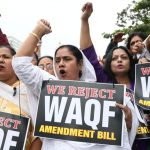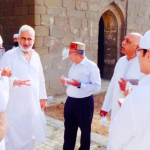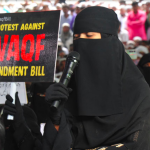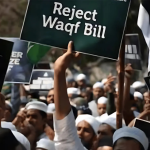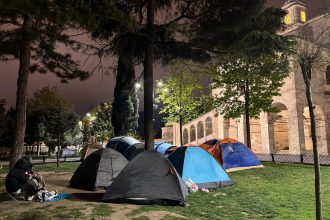A journalist friend called me recently to discuss a story on the Haj. His central question was straightforward: why should the government spend public money on a religious pilgrimage? He noted that the Ministry of Minority Affairs has a dedicated Haj Section, and claimed that large sums—running into lakhs and even crores—are spent on facilitating the pilgrimage for Muslim citizens.
As our conversation progressed, it became evident that his questions were shaped by a growing discourse circulating on social media—what many now refer to, half-jokingly, as ‘WhatsApp University.’ A recurring narrative there argues: if the government facilitates the Haj, why shouldn’t similar support be extended to Hindu pilgrimages such as the Char Dham Yatra?
The Annual Cycle of Misinformation and Communal Narratives
This line of questioning isn’t new. For nearly two decades, I’ve observed a familiar pattern emerge in the lead-up to Eid-ul-Adha: a surge of misinformation, often laced with communal undertones. Year after year, self-styled animal rights activists and social commentators resurface the same claims—not to foster dialogue or understanding, but to weaponise the festival and its rituals, fuelling division rather than reflection.
But beyond the emotional rhetoric and viral half-truths lies a more sober and inconvenient reality—one that barely features in the mainstream narrative.
A Statutory Body Operating Without Government Funds
It is important to understand that the Government of India has established the Haj Committee of India—commonly known as the Central Haj Committee—to oversee and facilitate all arrangements related to the Haj pilgrimage for Indian Muslims. Initially, this committee fell under the Ministry of External Affairs, but since October 1, 2016, it has been placed under the jurisdiction of the Ministry of Minority Affairs.
However, despite being a statutory body, the Haj Committee of India does not receive any financial assistance from the Government of India, unlike many other statutory organizations. This has been officially confirmed by the Ministry of Minority Affairs.
In response to a Right to Information (RTI) request I filed, the Haj Division of the Ministry stated on March 21, 2025: “No grant-in-aid is given by the Ministry of Minority Affairs either to Haj Committee of India, Mumbai or any State Haj Committees after transfer of Haj matter from MEA to MoMA i.e. from 01.10.2016 onwards.”
That means zero rupees—no central funds, no subsidies, no line-item allocations. In practical terms, the Committee functions as a self-reliant, self-funded body that operates under central regulation, but without any budgetary support.
You may be surprised to learn that the Haj Committee of India—one of the statutory bodies established through an act of Parliament—is perhaps the only such institution in the country that is entirely controlled by the government, yet receives no financial assistance from it. In fact, not only does it function without government funding, but it also bears the expenses of ministers and government officials involved in Haj-related activities.
Pilgrims Pay the Price—and the Salaries
The entire expenditure of the Haj Committee of India is covered by the pilgrims themselves—Muslims from across India who travel to Mecca and Medina each year to perform Haj. I discovered this firsthand in 2018 while researching a story and speaking with the then CEO of the Haj Committee of India, Dr. Maqsood Ahmed Khan.
He told me clearly, “No one gives even five paisa to the Haj Committee. The salaries of every officer and staff member working in the office are paid from the contributions made by the pilgrims. Even my own salary is paid from the same fund.” It is important to note that the CEO of the Haj Committee is typically an IAS officer or a government-appointed official.
When asked if any financial support is received from the central government, he responded without hesitation: “Not a single rupee. In fact, the expenses of all official meetings involving ministers and government officials are also borne by the Haj Committee of India.”
And what role does the government play? To that, Dr. Khan candidly remarked, “Nothing, except interfering in our work and regulating us.”
In the same year, 2018, I also spoke to the then Chairman of the Haj Committee of India, Chaudhry Mehboob Ali Qaiser, regarding this matter. He confirmed, “CEO Dr. Maqsood Ahmed Khan is absolutely right. The Haj Committee of India does not receive any aid or grant from the Government of India. It operates entirely on the contributions made by the pilgrims.”
An official from the Haj Committee further informed me that the committee generates additional revenue by renting out the Haj House hall in Mumbai. For weddings, the rent is typically around ₹50,000 to ₹60,000, while discounted rates are offered for religious or social events. Moreover, the committee earns crores of rupees annually from interest accrued on funds kept in the bank.
The Myth of Government-Constructed Haj Houses
A widely held misconception is that the central government funded the Mumbai Haj House, the Committee’s headquarters. The truth is starkly different.
The bitter truth is that the Government of India has had no role in the construction of the Mumbai Haj House, the headquarters of the Haj Committee of India. The building’s construction began on 7 March 1983, and no assistance or loan was taken from the central government for this purpose. All expenses were borne entirely by the Haj Committee itself.
Take the Mumbai Haj House, for instance—it has 102 rooms and a fully air-conditioned hall. In fact, most Haj Houses across the country have been built using funds from the Haj Committee of India itself. While some state governments have occasionally offered support, the involvement of the central government has been minimal, if not entirely absent.
Where Is the Ministry of Minority Affairs’ Haj Budget Going?
It’s also important to examine the Ministry of Minority Affairs’ own scheme titled Special Programme for Minorities, which includes provisions for managing the Haj in India and Saudi Arabia. Under this scheme, ₹82.05 crore was spent in 2019–20. However, in the subsequent two financial years—2020–21 and 2021–22—when no Indian pilgrims were able to travel due to COVID-19, the ministry still spent ₹4.92 crore and ₹7.10 crore, respectively. Meanwhile, as previously noted, the Haj Committee of India maintains that it does not receive any financial support from the Ministry. This raises a pertinent question: if no pilgrims travelled during those years, and the Committee itself was not a recipient, where exactly was the ₹12.02 crore spent under the banner of Haj management?
In 2022–23, ₹61.56 crore was spent under this scheme. The following year, in 2023–24, that figure rose to ₹83.51 crore. Last year (2024–25), the scheme was allocated a budget of ₹129.46 crore, and for the current financial year (2025–26), the budget has further increased to ₹143 crore. Where exactly this money is being spent remains unclear—only the Ministry of Minority Affairs can provide that answer. It’s also worth recalling that during the UPA era, when the Haj Committee of India operated under the Ministry of External Affairs, government expenditure on Haj-related arrangements was minimal. For instance, in 2013–14, the government spent just ₹3.09 crore on Haj arrangements.
What must not be overlooked is that for Muslims, the Haj is a deeply sacred act of worship—obligatory once in a lifetime for those who are physically and financially able. A devout Muslim often spends years, even decades, saving through honest labour for this spiritual journey, all the while praying for the divine invitation to the House of Allah. Yet, in stark contrast to its sanctity, Haj has become a significant revenue stream for various government departments in India. Prominent among these are the Ministry of Minority Affairs, Ministry of External Affairs, Ministry of Health, Ministry of Civil Aviation, and the Haj Committee of India. Despite this, misleading narratives continue to circulate each year, distorting the realities of government involvement in the Haj process.
Haj: A Sacred Obligation or a Revenue Source?
What is particularly troubling is that while ordinary Muslims bear the financial burden of Haj, some government officials and institutions have turned it into an opportunity for profiteering. Allegations of corruption have surfaced repeatedly. In 2024, Member of Parliament Asaduddin Owaisi raised serious concerns in the Lok Sabha about large-scale corruption within the Haj Committee of India, calling for an investigation by the Central Bureau of Investigation (CBI). Similarly, in 2023, Congress leader and former Maharashtra Minister for Minority Development, Arif Naseem Khan, wrote to Prime Minister Narendra Modi, alleging a “major scam” in the management of Haj 2023.
Despite these grave allegations, the Government of India has yet to initiate any formal investigation into the matter. The silence raises critical questions about accountability, transparency, and the integrity of institutions entrusted with managing one of Islam’s most sacred obligations.
The Reality Behind Hajj Facilities: Transparency & Accountability in Question
It is worth noting that while the Indian government consistently claims to provide the best possible facilities to Haj pilgrims, the reality on the ground often tells a different story. Despite collecting full payments in the name of services, Indian pilgrims reportedly face some of the most difficult conditions in Saudi Arabia.
Take the 2024 Haj season, for instance. Pilgrims staying in the Mina camps encountered numerous hardships, with Indian camps reportedly being among the worst in terms of infrastructure and management. This, despite each pilgrim being charged a substantial amount—specifically 4,900 Saudi Riyals (approximately ₹1.09 lakh at the 2024 exchange rate)—as the Muallim or Tawafa Establishment fee for a stay of just five to six days in camps.
The Mystery of Bilateral Agreements and Secrecy
This raises several important questions: What are the actual terms of the bilateral agreement between India and Saudi Arabia concerning these charges? What facilities are South Asian Mossassa (the bodies responsible for providing services to pilgrims) contractually obliged to offer to Indian pilgrims? And most importantly, is the fee collected from Indian pilgrims proportionate to the services they receive?
To gain clarity, I filed a Right to Information (RTI) request on February 22, 2025, seeking copies of the bilateral agreements between the Government of India and the Kingdom of Saudi Arabia for the past five years. The Ministry of Minority Affairs, however, denied the request. The Haj Division cited Section 8(1)(f) of the RTI Act, which exempts from disclosure any information received in confidence from a foreign government.
Transparency, Trust, and the Rights of Pilgrims
Such secrecy is troubling. What elements of the bilateral agreement are so confidential that they cannot be shared with the public, especially with the pilgrims whose hard-earned money is being used? Why should basic questions of transparency and accountability, particularly concerning financial transactions and service delivery, be shielded behind claims of diplomatic confidentiality?
These are not merely bureaucratic questions. They strike at the core of governance, public trust, and the fundamental rights of Indian citizens striving to fulfil a deeply personal religious obligation.
Afroz Alam Sahil is a freelance journalist and author. He can be contacted at @afrozsahil on X.


